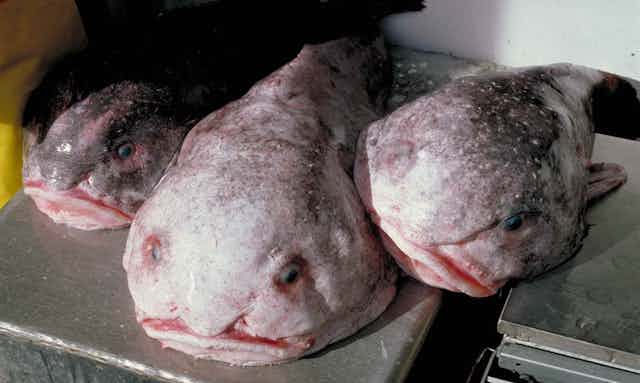Fans of the movie Finding Nemo may remember the terrifying fish that scares Dory (a blue tang) and Marlin (a clown fish) at the bottom of a trench.
But in reality this “monster”, a black seadevil, is only about 9 cm long, which would make it about a third of the size of Dory and potentially smaller than Marlin or Nemo.
In 2014, researchers at Monterey Bay Aquarium Research Institute began studying a single black sea devil. It was caught and moved to a special darkroom laboratory designed to simulate its dark and cold natural habitat.
While this misconception or inaccuracy may seem harmless, it could pose problems for future conservation efforts, as people are more likely to support conservation of cute rather than creepy-looking animals.
While the angler fish is easily turned into a scary monster, the similar-sized tiny Pac-Man looking octopus is cute and popular with the public.
Deep sea commercial fishing nothing to celebrate
From 2000-2010, scientists described about 1,200 new species in the Census of Marine Life Program. While this figure may seem astounding, a further 5,000 individual dead creatures are in specimen jars, waiting to be described. The scientific process of describing new species is slow.
Specimens must be methodically collected, identified, and then the identity of new deep-water species must be confirmed.
People have always had a fascination for unusual creatures that they may never see. Many exotic land animals can be seen in zoos around the world, but few deep sea species are on display in aquaria. In the meantime, people on social media are hungry for images of strange and exotic animals of the sea.
As a result, a Russian fisherman working on deep sea commercial trawlers last year gained huge numbers of social media followers after posting photos and videos of some of the deep sea creatures caught on his ship, with some even stuffed by craftsmen on board.
Presumably, many of these specimens are bycatch, accidentally caught in nets trawling for other species popular with consumers. Sometimes bycatch, which includes marine mammals, is thrown back into the sea but it may end up on consumer plates.
If images are posted on social media by laypeople in a way that appears sensational and even heartless, and without any accurate information about the animals, then there is no resulting respect for these sea creatures or educational value. Simply viewing these creatures as freaks, ignores the importance of their role in keeping our oceans healthy.

Deep in danger
Most people will never spend time on a trawler fishing in deep oceans, but marine conservation and management policy depends on all of us being aware of the risks that human activities pose to marine ecosystems, such as deep water fishing, off shore mining and pollution.
If we call unusual deep sea animals monsters or demons or freaks, then we may harm their conservation as people are unlikely to connect with them or care about saving them.
On the other hand, their rarity clearly makes them popular on social media sites. For other species, this has resulted in increases in illegal trafficking for exotic pets, and aquariums. Deep sea species may potentially become illegally sourced taxidermy curiosities or food. Humans may end up eating these animals of the deep to extinction before their species are even known to science.

Saving our ‘blue heart’
We still have so much to learn about deep marine ecosystems and their inhabitants, which have special adaptations for living in these typically cold and dark waters. With new submarines and technology, scientists are able to explore the ocean more easily.
The deepest part of any ocean is the Challenger Deep valley in the Mariana Trench, part of the Pacific Ocean, which is about 11,000 metres deep. By comparison, Mount Everest is about 8,550 metres tall.
The cold water of the North Atlantic, down to depths of about 1,800m, is home to the Greenland Shark, which can live for as long as 400 years!
A new species of beaked whale has also been discovered recently. It is smaller and darker than other beaked whales, perhaps because it forages for deep sea fish and giant squid at depths of up to 3,000m below sea level.

Every habitat on earth is interconnected, and whatever we as humans do on the ground, or in the oceans has an impact on marine ecosystems. Removing deep sea predators and prey, and disturbing deep sea habitats, will change marine ecosystems in ways that we do not yet understand.
Some experts have compared the rapid global spread of unsustainable fishing technologies and practices to a pathological disease outbreak. Oceans are sometimes called the lifeblood of our planet, while rainforests are its lungs.
In reality, about 80% of our oxygen is produced by microorganisms in the oceans. This makes our oceans both the lungs and lifeblood of our planet. In fact, oceans are the blue heart of our planet and we must all try harder to save them.

